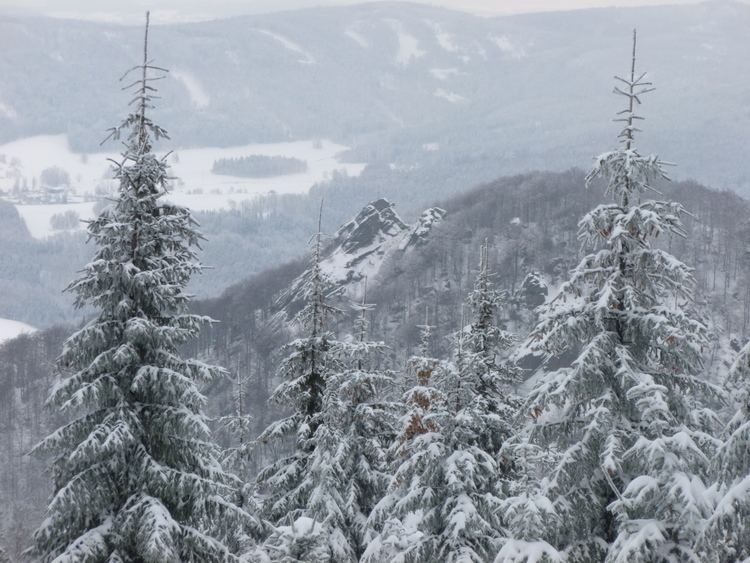Peak Wysoka Kopa Elevation 1,127 m Mountains Smrk, Slovanka | Type of rock Granite and Basalt Highest point Smrk Types of rock Granite, Basalt | |
 | ||
Similar Krkonoše, Ještěd, Smrk, Sudetes, Bohemian Paradise | ||
Jizera Mountains (Czech: Jizerské hory) or Izera Mountains (Polish: Góry Izerskie; German: Isergebirge) are part of the Western Sudetes on the border between the Czech Republic and Poland. The range got its name from the Jizera River, which rises at the southern base of the Smrk massif.
Contents
Map of Jizera Mountains, Czechia
Geography
The range stretches from the Lusatian Mountains (Zittau Mountains) in the northwest to the Krkonoše in the southeast. The Jizera Mountains comprise the sources of the Jizera river, as well as of the Kwisa and the Lusatian Neisse.
The major part in the south is formed from granite, in the northern part from gneisses and mica schists, with some areas formed from basalt.
The weather conditions are characterized by above-average annual precipitation. On 30 July 1897, the measuring station at Nová Louka recorded a daily precipitation amounting to 345.1 mm (13.6 inches), still an unbroken European record.
Peaks
The highest peak is Wysoka Kopa (Hinterberg, 1,127 m, 3,698 feet) near the town of Szklarska Poręba in Poland. Neverteheless, a better-known mountain is Smrk (1124 m, 3,688 feet), with a recently rebuilt look-out tower. Other peaks include Jizera (1,122 m, 3,681 feet) and Stóg Izerski (Heufuder, 1,107 m, 3,632). The peaks in order of elevation:
History
The first settlements in the area date back to prehistory. Later on, Celts, German tribes resides in the valleys until they left in 5th century. Later came Lusatian Sorbs. In the 14th century, German-speaking colonists came and started clearing of the dense primeval forests. Permanent settlements were established. In the 16th century, several glass works were founded. Glassmaking had a profound effect on the ecosystem. The primeval forest was gradually replaced by fast-growing spruce monoculture. Other important industries included tin-mining, metallurgy and textile. The Tabulový kámen (German: Tafelstein), 1072 m) on the northern edge of the Smrk Mountain marked the border between the properties of the Counts of Gallas in Friedland, Bohemia, the von Gersdorff family from Meffersdorf, Upper Lusatia (Unięcice, now part of Wigandsthal) and the Counts of Schaffgotsch from Schreiberhau, Silesia.
In the second half of the 20th century the character of the Jizera Mountains changed completely. The German population of the area was expelled in 1945 and replaced by Poles on the now Polish and Czechs on the Czechoslovakian side of the mountains. The ecosystem was badly hit by emissions, produced by lignite fired power stations located in the Zittau basin, part of Europe's ecological Black Triangle. Weakened spruce forest, less resistant against various types of parasites, were on the verge of extinction. The higher parts of the mountains, once densely wooded, became largely treeless, in part also because of excessive deforestation. New roads cut through the once-secluded landscape.
The situation improved only after the fall of communism in 1989. Open-pit coal mines in the former East Germany were closed, as well as several major power plants. Emission filters were installed at the immense Turów Power Station in Bogatynia on the Polish side of Lusatian Neisse. At the same time large-scale reforestation projects were started.
Tourism
The Jizera Mountains are an attractive location for winter sports, cycling and hiking. The centre for both downhill skiing and ski run is Bedřichov. The international cross-country races Jizerská 50 and Bieg Piastów (in Polana Jakuszycka) take place there. Its summer MTB counterpart is also gaining popularity.
The towns surrounding the mountains include Liberec, Frýdlant v Čechách, Nové Město pod Smrkem, Świeradów Zdrój, Szklarska Poręba, Desná, Tanvald and Jablonec nad Nisou.
